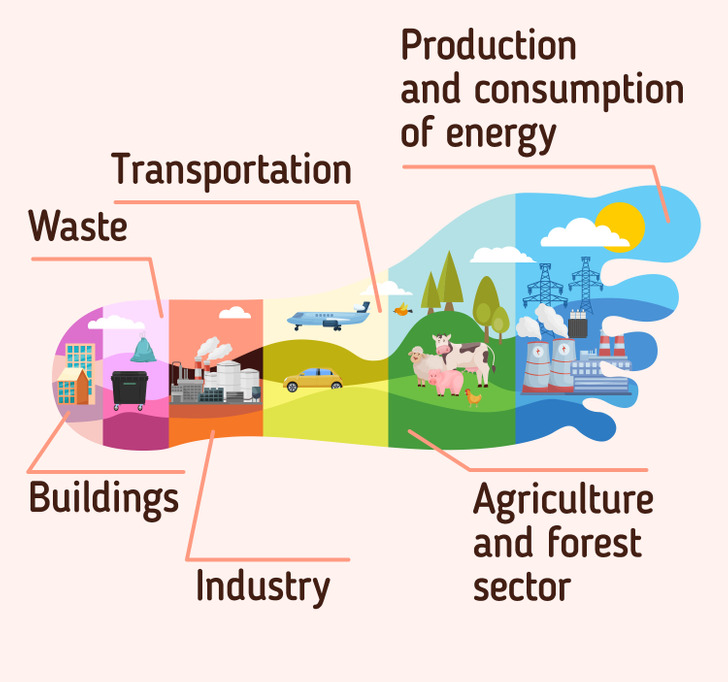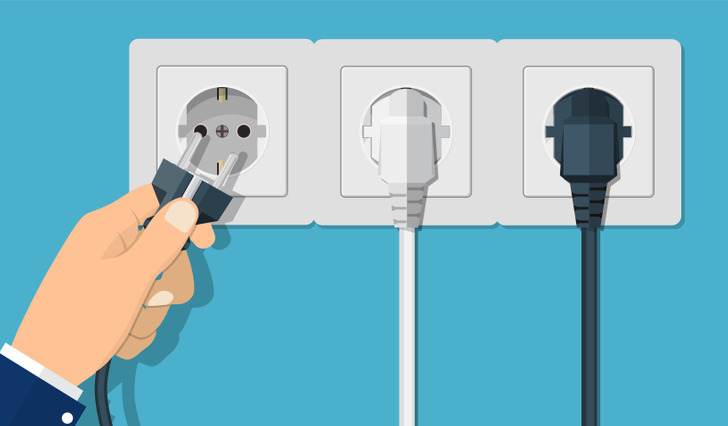A Simple Definition of a Carbon Footprint and What Our Own Carbon Footprint Consists Of
Every day we do so many things: we go to work or travel to the country side, we heat our houses in the cold season and sit under air conditioning in summer, we cook food, eat strawberries, buy another pair of sneakers or jeans. Surprisingly, all these and many other actions contribute to climate change and leave a carbon footprint.
5-Minute Crafts decided to find out what a carbon footprint is and how it is formed. Also we will tell you about what each of us can do in our everyday life to reduce the negative effect of our activity on the climate and environment.
What is a carbon footprint?
Everything around us, from a cell phone and computer we use to a T-shirt we wear, has its own carbon footprint. Flights and car trips we take per year, or meat and dairy products we consume also leave a carbon footprint on the environment.
In simple terms, a carbon footprint is the total amount of greenhouse gas emissions produced to support our activities and lifestyle during a year, expressed as carbon dioxide (CO2) equivalent.
A greenhouse gas has the ability to trap heat in the Earth’s atmosphere. The primary greenhouse gases are water vapor (H2O), methane (CH4), carbon dioxide (CO2), nitrous oxide (N2O), and ozone (O3). A healthy concentration of these gases in the planet’s atmosphere is necessary to maintain habitable temperatures. Without them, the average temperature of the Earth’s surface would drop to 0°F, and this would make our planet uninhabitable for most species.
However, when the concentration of greenhouse gases increases, it makes the average global temperature higher. It is this effect that occurs inside greenhouses which is why these gases are called greenhouse gases.
This rise in temperature leads to global warming, which has disastrous effects on the planet we live on. So the smaller our carbon footprint is, the better it is for the planet and our future. These are the effects of global warming:
❌ melting of the ice caps
❌ disruption of rainfall patterns, leading to floods or droughts, which affects the crop yield and can lead to crop losses
❌ intense and more frequent storms
❌ risk of species survival in higher temperatures
❌ loss of biodiversity
What is a carbon footprint formed from?
Almost all human activities — agriculture, manufacturing, transportation, commercial and residential sectors — require energy in the form of fuel, electricity, and heat. The production of these types of energy results in the emission of greenhouse gases into the atmosphere. Thus, the value of a carbon footprint can be associated with any product.
The distribution of a carbon footprint varies from country to country. The countries with more advanced industrial sectors naturally have higher carbon and greenhouse gas emissions. The biggest sources of carbon emissions are such sectors of the economy as energy production, transportation, agriculture, and manufacturing industry.
Here are a few examples of the effects of greenhouse gas emissions in our everyday life:
- Jeans are made from cotton, which requires almost 20,000 liters of water to produce 1 kilogram. Manufacturing a single pair of jeans emits approximately 20 kilograms of CO2.
- The carbon footprint of a laptop can be 350 kilograms of CO2 equivalent. This number is made up of CO2 which is emitted during the mining of metals, the manufacturing of glass and plastic, the shipment of finished products to stores, as well as the electricity needed to run your laptop.
- A car ride is equivalent to 270 grams of CO2 per kilometer.
How can you reduce your carbon footprint?
Transportation use:
- Stop using your personal car to get to work or take your children to school. Choose walking, cycling, or public transport.
- Avoid air travel whenever possible. For example, travel by train.
- Avoid short car trips because fuel consumption and CO2 emissions are too high given the time it takes for the engine to warm up.
Food and drinks:
- Try not to throw away food.
- Eat seasonal and local produce — every mile that food travels from the manufacturer to the final consumer increases the carbon footprint of the product.
- Cut down on dairy products. Livestock that produce milk and other dairy products requires a lot of resources that put a strain on the environment.
- Cut down on meat. Meat production uses a lot of water and emits greenhouse gases into the atmosphere.
- Recycle organic waste.
Clothing:
- Avoid so-called “fast fashion” brands. Often this cheap clothing is of poor quality, it goes out of fashion quickly, and is sent to the trash. And while it decomposes, it produces methane.
- Buy vintage clothing as well as clothing made from recycled materials.
- Feel free to buy clothes in second-hand stores. This is one of the ways to refresh your wardrobe while keeping your carbon footprint low. This approach is good for both your expenses and the environment.
- Donate clothes you don’t like anymore to charity or give them to your friends.
Energy use and energy saving:
- Unplug your cell phone charger when not in use.
- Turn off any other electrical devices when not in use. Household appliances, including computers, TV sets, and microwaves continue to consume energy even when turned off. Each standby device consumes very little power on its own but together they can account for up to 10% of residential energy use.
- Use energy saving lamps or LEDs.
- If you live in an apartment or house with autonomous heating, reduce the heating power. This will reduce your family’s energy bill and CO2 emissions.
- Use caulk or insulation to seal any heat leaks in your home.
- Don’t use air conditioners: they are real energy eaters. A fan can be an alternative to an air conditioner.
- Defrost old refrigerators and freezers regularly.
Recycling:
- Recycle as much trash as possible.
- Choose products with minimal packaging.
- Use reusable shopping bags for your purchases.
Water use:
- Turn off the water while you brush your teeth or do dishes.
- Repair all leaking faucets in your home promptly.
- Cover pots with lids while cooking.
- Cut down on bottled water.
- Take a shower instead of a bath.
- Use the washing machine and dishwasher only when they are full.



